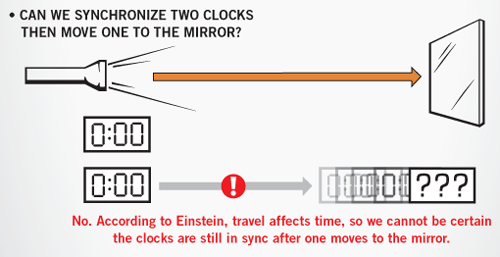
Distant Starlight—The Anisotropic Synchrony Convention
Einstein’s theory of relativity launched a new way of looking at the universe. But one question remained: How long does it take light to reach the earth? The answer depends on your assumptions. “Instantly!” declares a new creationist theory.
In virtually all areas of science, we find evidence that strongly confirms the Genesis account of creation. And yet a few facts don’t seem to fit on the surface. It really shouldn’t surprise us that we don’t always correctly understand every facet of the universe.
After all, our minds are finite and fallible, and the universe is complex, and we have explored so little of it. But often, if we persevere, the Lord allows us to discover new things about His creation, and we realize that what seemed like a problem at first glance is, in fact, perfectly in line with Genesis. One of these apparent problems is distant starlight.
The Problem
Scientists have known for nearly a century that the universe is very, very large. Some galaxies are so far away that even light (traveling at 186,000 miles per second [300,000 km/sec]) would take billions of years to travel that distance, at least from our finite understanding. But since we see these galaxies, their light must have traveled from there to here.
So if the light really took billions of years to get here, then the universe (or at least those galaxies) would therefore be billions of years old. But this interpretation clashes with a straightforward reading of the Bible, which indicates that God created the universe only a few thousand years ago.
To deal with this issue, various scientists over the years have proposed models, such as a changing speed of light and “gravitational time dilation.” It should also be noted that secular astronomers have their own time-travel problem—called “the horizon problem” (the big bang cannot explain how light could have traveled across the universe to produce uniform “background” temperatures1).
I believe that we may now have the answer to this question.
Contrary to popular belief, it is possible for light to move instantaneously even today. So, the amount of time it takes for light to travel from the most distant stars to earth is actually zero—not only during Day Four of Creation but today as well.
The light-travel problem is more about underlying assumptions than things we can observe and study with empirical science.
This principle was not discovered by a biblical creationist in an attempt to solve the starlight problem. Rather, it was discovered by Albert Einstein. It shows that the light-travel problem is more about underlying assumptions than things we can observe and study with empirical science.
Warning to those unfamiliar with Einstein’s theory of relativity: this will seem counterintuitive, so be prepared to think outside the box!
The Physics of Einstein
Einstein’s discoveries changed the way we think about space, time, and light. Before the twentieth century, most people thought that space and time are not affected by velocity (speed and direction). Our everyday experience seems to confirm this; our clocks don’t seem to tick slower when we drive a car. And the car’s length doesn’t seem to change with speed.
But around the turn of the century, Einstein showed that our intuition of such things can be very misleading. Velocity does indeed affect the passage of time, and it affects our measurement of length as well.
However, these effects are very small whenever speeds are extremely slow compared to light. But all of our experiences take place at speeds much slower than light. So in our daily lives we never notice the effects that Einstein discovered.
In fact, you would have to travel at 14% the speed of light in order to notice a 1% effect in the length of an object or the rate of a clock. Since no human being has ever moved that fast, no one has ever really experienced these effects in our everyday lives. However, physicists have been able to accelerate particles (smaller than an atom) to nearly the speed of light. And these particles behave exactly as Einstein predicted. Since lengths and time-durations are not absolute but are relative to velocity, Einstein’s physics is often referred to as “relativity.”
The One-Way Speed of Light
A less-well-known aspect of Einstein’s physics is that the speed of light in one direction cannot be objectively measured, and so it must be stipulated (agreed upon by convention). This stands in contrast to the round-trip speed of light, which is always constant.
For example, if light travels from A to B and then back to A, it will always take the same amount of time to make the trip (because its speed is always the same), and that time is objectively measurable. However, the time it takes to go just from A to B, or just from B to A is not objectively measurable. So the speed of light in one direction must be stipulated.
What We Know About the Speed of Light
We can calculate the round-trip speed of light. Let’s say, for example, we shine a light down a long hallway and it reflects off a mirror. If our stopwatch says it takes 2 seconds to go round trip, we can be sure of this time.

What We Don’t Know
While we can be certain of the round-trip time, we cannot be certain of the time it took the light to travel to the mirror or the time it took to return.

Finding the One-Way Speed of Light
In order to avoid assuming the time for one-way speed of light, we need to be able to measure the one-way trip. But it is impossible because moving a clock to the mirror may change the time on the clock!


In other words, we are free to choose what the speed of light will be in one direction, though the “round-trip” time averaged speed is always constant.
The reason that the one-way speed of light cannot be objectively measured is that you need a way to synchronize two clocks separated by a distance. But in order to synchronize two clocks separated by some distance, you have to already know the one-way speed of light. So it cannot be done without circular reasoning.
We need to have a way of synchronizing clocks to know the one-way speed of light. But we need to know the one-way speed of light in order to synchronize clocks. Einstein was well aware of this dilemma. He said, “It would thus appear as though we were moving here in a logical circle.”2
Einstein’s resolution to this dilemma was to suggest that the one-way speed of light is not actually a property of nature but is instead a convention—something that we may choose! For the sake of simplicity, many physicists choose to regard the speed of light as being the same in all directions.
However, any other choice is also acceptable, so long as the round-trip speed is 186,000 miles per second. Einstein said that light’s one-way speed “is in reality neither a supposition nor a hypothesis about the physical nature of light, but a stipulation which I can make of my own freewill in order to arrive at a definition of simultaneity.”3
Distant Starlight
So we may choose to regard the speed of light as being instantaneous when travelling toward us, providing the round-trip speed (in empty space) is always 186,000 miles per second. In this case, the light from distant stars takes no time at all to reach the earth since the light is travelling toward us. So distant starlight is not an issue.
This convention could be called the “anisotropic synchrony convention,” or ASC, because it claims that light travels at different speeds in different directions (anisotropic). Of course, it’s perfectly fair to use other conventions as well.
Einstein tells us that we may freely choose which convention to use. For the sake of simplicity, most physicists choose to regard light as moving at the same speed in all directions (isotropic). However, there is no fundamental reason that we cannot use ASC instead.
It appears that the biblical writers used the ASC convention. Genesis 1:15 tells us that the lights in the heavens were designed to give light upon the earth, and it also tells us “and it was so.” This strongly suggests that the stars immediately began fulfilling their God-ordained purpose to give light upon the earth.
ASC is the only convention in which light from all stars in space would reach earth instantaneously, as we might infer from Genesis. It is also the convention implicitly used by all ancient cultures (though they probably would not have thought about it in quite the way we do today).4
God wants people to read and understand His Word (as He teaches in Deuteronomy 30:11–14 and elsewhere). ASC would be the best convention to use to accomplish this, since it would be used by ancient cultures and is still used today.
If we understand that the Bible in Genesis (and throughout) uses ASC, then this explains how we can see light from the most distant galaxies; God created the celestial lights on Day Four and it took that light no time at all to reach earth (because the light was on a one-way trip). So Adam would not have needed to wait 4.3 years for Alpha Centauri to become visible. He could have seen the star immediately, along with all the other stars.
For the purposes of developing a scientific model of cosmology, we can make some additional assumptions about the universe and how God might have originally distributed the material within it. These suppositions have led to the development of a creation-based model of cosmology that makes testable predictions.
Many of the predictions of this “ASC model” have already been confirmed, and we expect many more in the near future. For more information on the ASC model, please visit our free Answers Research Journal at www.answersingenesis.org/arj.
Bottom line. We don’t have all the data about the universe—we weren’t there at the beginning—and so, like Job, we should humbly acknowledge that we know nothing compared to God (Job 42:1–6). Nonetheless, God allows us to understand some aspects of His cosmos, and we may now have the answer to the challenge of distant starlight. Research on this topic continues, but we should always stand uncompromisingly on God’s Word.
“Virtual” Starlight?
In the past, some creationists thought that God may have simply created the light beams themselves. In other words, when we look at a distant galaxy, we are not actually seeing light that came from the galaxy but rather a picture of a galaxy that God placed in a beam of light at creation.
This view also means that anything we see happening in distant space (such as a star exploding) never actually happened. Celestial events would simply be fictional movies created by God. But this doesn’t seem consistent with the character of God as described in the Bible (1 Corinthians 14:33).
Even more significantly, this view seems to clash with what the Bible itself says about the stars. Genesis 1:15 teaches that God made the lights in the heavens to give light upon the earth. But if God created the light in-transit, then the light doesn’t actually come from the stars. This would mean that more than 99% of the universe is not yet fulfilling its God-ordained purpose: to give light upon the earth.
But Genesis 1:15 also says “and it was so,” which implies that the stars instantly began fulfilling their God-ordained role. So the light beams were not created in place. Apparently the light actually did come from the stars. In addition, Genesis seems to imply that this happened immediately.
Answers Magazine
January – March 2011
This issue of Answers points a telescope at the heavens. Explore evidences that the universe is young, from blue stars to spiral galaxies. Get up-to-date on the search for extraterrestrial life, and be the first to read Dr. Jason Lisle’s new model explaining distant starlight. You also don’t want to miss articles on living fossils and other wonders of our own planet that point to a recent creation and global Flood.
Browse Issue SubscribeFootnotes
- See The New Answers Book, Chapter 19 (Green Forest, Arkansas: Master Books, 2006), pp. 251–254.
- A. Einstein, Relativity: The Special and General Theory, authorized translation by R. W. Lawson (New York: Crown Publishers, 1961), pp. 22–23.
- Ref. 2, p. 23.
- As far as we know, ancient cultures did not subtract a light-travel time from cosmic events. As far as they were concerned, things in space happened at the same time they were seen. This is the essence of ASC.
Recommended Resources

Answers in Genesis is an apologetics ministry, dedicated to helping Christians defend their faith and proclaim the good news of Jesus Christ.
- Customer Service 800.778.3390
- © 2024 Answers in Genesis









